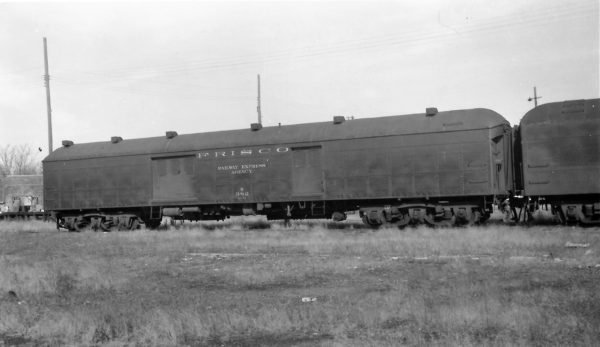69 Foot Baggage Car 382

69 Foot Baggage Car 382 at Springfield, Missouri on February 17, 1963 (Arthur B. Johnson).

69 Foot Baggage Car 382 at Springfield, Missouri on February 17, 1963 (Arthur B. Johnson).
U30B 845 at Tennessee Yard on August 6, 1974.
Location is Memphis, Tennessee.
This is the mechanical department’s diesel service tracks area at Tennessee Yard. The locomotives are sitting on the wash rack track just northwest of the diesel shop. Additional locomotives visible in consist include SD40-2 UP 3135 and SD40 UP 3115. In the distance on the receiving and departure (R&D) yard tracks are several interesting Frisco color coded freight cars. These cars featured routing information indicating “Return to Agent Frisco Railway Memphis Tennessee”.
On the left is a blue SLSF 15500-15574 series (75 cars) 50’6” inside length, 4,828 cubic foot, smooth slab plug door boxcar. These load restraining equipped (XL) cars featured Evans DF-2 (damage free, 2nd generation) belt rails. Note these cars did not have an explanation mark (!) following the slogan “Ship It on the Frisco”. These cars were in assigned service to General Foods Corporation. General Foods products at the time included Post brand cereals including Grape Nuts and Post Toasties, Jell-O, Minute Rice, Log Cabin Syrup, Sanka and Maxwell House coffee and Birdseye brand frozen foods.
To the right are orange SLSF 15000-15099 series (100 cars) 40’6” inside length, 3,898 cubic foot, exterior-post lug door boxcars. They are in special assigned service to Kellogg Company. Memphis is host to one of the company’s cereal products plants just northeast of Frisco’s Yale Yard. Products produced at the plant have included Kellogg’s Corn and Frosted Flakes, Rice Krispies Treats and granola clusters. The plant address is 2168 Frisco Avenue, Memphis, Tennessee 38114.
Also visible in the left photograph is the west signal for the 250’ U-shaped vehicle tunnel underpass beneath the receiving and departure (R&D) tracks. This signal is interlocked to permit one way traffic through the single lane tunnel. Activating the push button at either entrance starts a timer and clears the appropriate signal. Once the signal times out, following or opposing traffic can reactivate the push button for the timer in the desired direction.
This tunnel connects the railroad service road between the mechanical department’s freight car repair-in-place (RIP) and diesel shops. A second similar 60’ tunnel runs under the north lead drill tracks into the yard bowl. It too is a single lane tunnel, though shorter in length, with interlocked vehicle traffic signals. This tunnel accessed the service road between and parallel to the yard bowl and the R&D tracks. Both tunnels are 16 feet in diameter, with a 9 foot wide roadway and include employee pedestrian walkways.
View is looking north.
Special thanks to Mark Davidson.

Four Frisco units at Oklahoma City, Oklahoma (date unknown).
The train is on the Chickasha Subdivision at bridge 541.6 over the North Canadian River. This is the Frisco’s second crossing of the river in the city. The bridge is southwest of the downtown central core. It is west of the Oklahoma City Union Depot, MP 540.1. The Union Depot was jointly operated by the Frisco Railway and Rock Island Railroad. The depot address is 300 Southwest 7th Street. The railroad bridge is sandwiched between the river crossings of Exchange Avenue, upstream to the northwest (left), and South Western Avenue, downstream to the southeast (right).
In 2005 the Frisco’s line past the depot and over this bridge was abandoned. This abandonment included the segment between the Santa Fe Railroad mainline overpass, MP 539.46, to the east and A.T.S.F. Crossing, MP 542.91, to the west. Traffic was rerouted over the former Fanta Fe line between these points. This was done to make room for the new route for Interstate 40, the Crosstown Expressway, south of downtown.
Visible in the city center are a number of prominent landmark buildings. On the right standing tall over the third unit is the 36 story Liberty Tower. Now named Cotter Ranch Tower, it is also known as Chase Tower. It was completed in 1971. At the time of its construction it was the tallest building in the city at 500 feet. Now ranked as the second, the 50 floor Devon Energy Center completed in 2012 is now the tallest building in the city.
Above the lead unit on the right with a tall rooftop spire topping out at 493 feet is the 1931 built, 33 floor, First National Bank Building/First National Center. It is located at 120 North Robinson Avenue. To its north (left in image) at 200 Park Place is the Art Deco style, 33 story, 1931 built, Ramsey Tower. It has been renamed the City Place Tower. At the time these were the second and third, today the third and fourth, tallest buildings in the city.
The tall building just to the left of the train is Kerr-McGee Tower at 123 Robert South Kerr Avenue. It too was constructed in 1971 and is 30 stories tall. The building was renamed in 2008 for its new owner SandRidge Center. On the far left the 22 story tall white building is The Regency apartment complex completed in 1966 at 333 Northwest 5th Street. In 1977, one block to the east, on the south side of 5th Street will be built the Alfred P. Murrah Federal Building. It will be the target of a domestic terrorist attack on April 19, 1995.
The known build dates of the large buildings, combined with the high horsepower locomotives and priority TOFC traffic help establish the time window to a narrow two year period. Post 1971 is established by the noted buildings. Priority trains QLA, QSF (westbound) and CTB (eastbound) were relocated from the Floydada to the Avard gateway through Enid by September 1973.
The view is looking northeast.
Special thanks to Mark Davidson.
GP38-2 677 at Enid, Oklahoma on December 23, 1980 (Gene Gant).